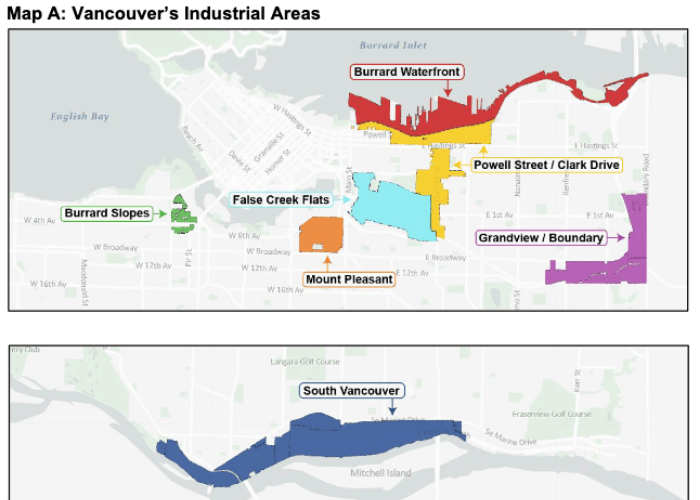- Vancity Lookout
- Posts
- A new Olympic Village? Some industrial sites could be opened up to new development
A new Olympic Village? Some industrial sites could be opened up to new development
Sites considered exceptional could be transformed into neighbourhoods like Olympic Village and Yaletown

What happened: Big changes could be coming to some prominent parts of Vancouver, as city staff look at how a handful of “exceptional” sites, including two industrial neighbourhoods, could be opened up to allow more types of use, including housing.
Councillors unanimously passed the motion, brought forward by Mayor Ken Sim, just before council went on its summer break.
Vancouver has seven industrial areas, most of which are clustered in East Van north of 12th Avenue. Broadly, the city’s intent behind zoning in these areas is to protect land for employment use.
Neighbourhood details: The specific sites up for review are the former Molson Brewery in Kits, a few blocks of city-owned land by Main Street and Terminal Avenue, and a car dealership just south of Marine Gateway near Marpole.
The two larger areas that will be looked at for zoning changes are the Railtown District near the Downtown Eastside and Brewery Creek in Mount Pleasant.
Sim acknowledged that what his motion defined as “exceptional” sites was subjective.
However, somewhere like the old Molson Brewery does seem to fit the bill. Sitting dormant since 2019, the site occupies a large, prominent space in the centre of town, located directly next to Sen̓áḵw, a major new planned community that’s currently being built.
Brewery Creek, or the Mount Pleasant Industrial Area, is less obviously in need of change. The area – bordered by Quebec and Yukon streets to the east and west and 2nd Avenue, and Broadway to the north and south – has become a thriving spot for craft breweries, restaurants, venues, businesses, and increasingly, big new office developments. It’s a part of town that’s usually buzzing with people who are attracted to the area from near and far.
All about transit: For the Marine Gateway and Main and Terminal sites, the allure of land use changes is directly tied to the nearby train stations at both locations. Sim noted that both spots are mixed-use areas with employment potential served by rapid transit.
Having housing in currently industrial-only areas allows people to work closer to where they live, Sim argued, specifically drawing on the need for nearby housing to attract healthcare workers for the new St. Paul’s Hospital.
Past policy shifts: It wouldn’t be the first time that shifting land use priorities in Vancouver have changed industrial areas into bustling residential neighbourhoods.
Councillor Peter Meiszner pointed out that places around False Creek, like False Creek South, Olympic Village, and Yaletown, were formerly industrial areas that have evolved into new neighbourhoods over the past 50 years.
Sim said the intent of getting staff to research possible zoning changes at these sites and areas is not about getting rid of industrial uses, but allowing for a mix, including housing, cultural spaces, and community amenities.
Staff who review development and project proposals may be in favour of certain redevelopments but “have their hands tied” by “rigid restrictions” imposed by the city’s industrial land use policies, Sim argued. About 6 per cent of land in Vancouver is zoned as industrial, according to a Metro Vancouver survey in 2020.
What’s next: Staff are expected to report back with their analysis of the exceptional sites by the end of October.